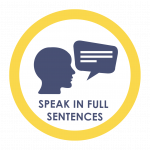UK lesson studies show that over 60% of questions teachers ask are factual rather than procedural, speculative or process-orientated. Over 70% of children’s own responses were also found to be 3 words or fewer.
Sinclair and Coulthard (1975) developed the Initiation – Response – Feedback framework. If followed, this framework allows us not only to ask better questions, but to also give pupils time to respond effectively and to improve their ideas, therefore engaging in exploratory talk.
- We must ask questions that require a high quality response (initiation)
- We need to have high expectations of pupil responses and support them to respond well
- We should provide feedback that moves beyond ‘great answer’ to ask for clarification, justification and reformulation of ideas
Strategies:
- The Question Matrix grid, from the ‘Teacher Toolkit’ reminds us that questions such as ‘Why will’ and ‘How might’ will generate better responses from pupils than the ‘what is’ or ‘when can’ questions. Question_matrix
- Speak in full sentences: Encourage pupils to respond well by asking them to answer in full sentences, this will improve the quality of their talk as well as any written response. (use this graphic to remind pupils of this in lesson slides)

- Develop high quality question stems to promote dialogic thinking: Use this graphic to reflect on the quality of your questioning in elevating pupils’ responses. Dialogic Q_stems
- Say it again, better: The Doug Lemov strategy focused on getting pupils to reframe and rephrase answers based on feedback.